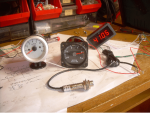gyrojake
Gyro Rehab Candidate
- Joined
- Jan 1, 2007
- Messages
- 2,313
- Location
- E-City, Florida
- Aircraft
- Gyroplanes
- Total Flight Time
- A few hours
Well I just spent my vacation money for a few years !! I bought a 1ghz (one gigahertz) Oscilloscope and a 4.7ghz RF spectrum analyzer.
I think I'm getting out of gyro building and start making wireless engine monitoring systems.
These tools are a must for my future endeavors.
I amazed myself with the wireless rotor tach and think this new project will be challenging and rewarding.
Now I gotta go burn one and wake up my last brain cell so I can accomplish this.
I will have to learn coding and hexadecimal programing for this adventure.
I guess we never stop learning if motivated properly.
Oh, and by the way, I will have this learned tonight !!
I think I'm getting out of gyro building and start making wireless engine monitoring systems.
These tools are a must for my future endeavors.
I amazed myself with the wireless rotor tach and think this new project will be challenging and rewarding.
Now I gotta go burn one and wake up my last brain cell so I can accomplish this.
I will have to learn coding and hexadecimal programing for this adventure.
I guess we never stop learning if motivated properly.
Oh, and by the way, I will have this learned tonight !!


